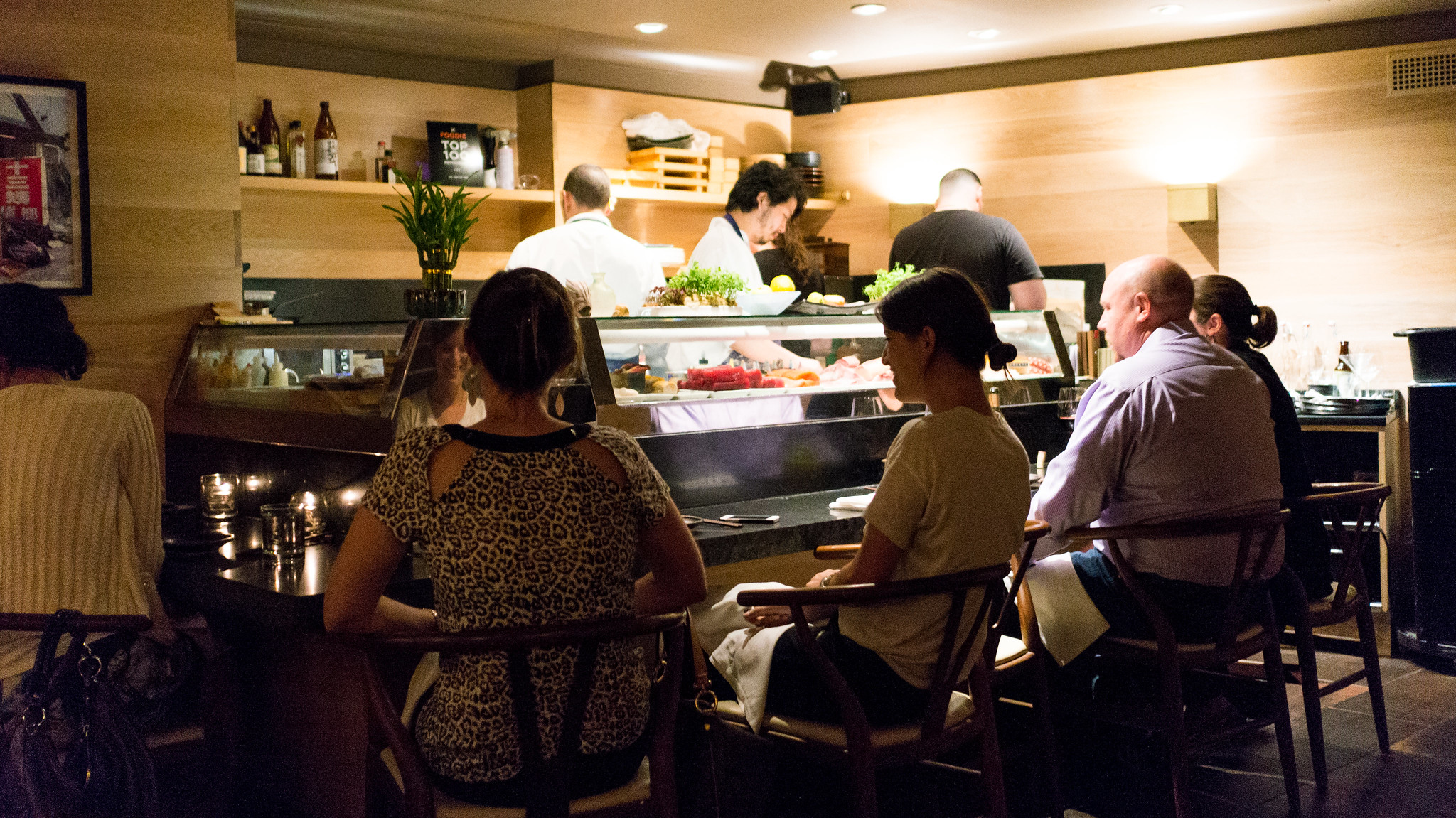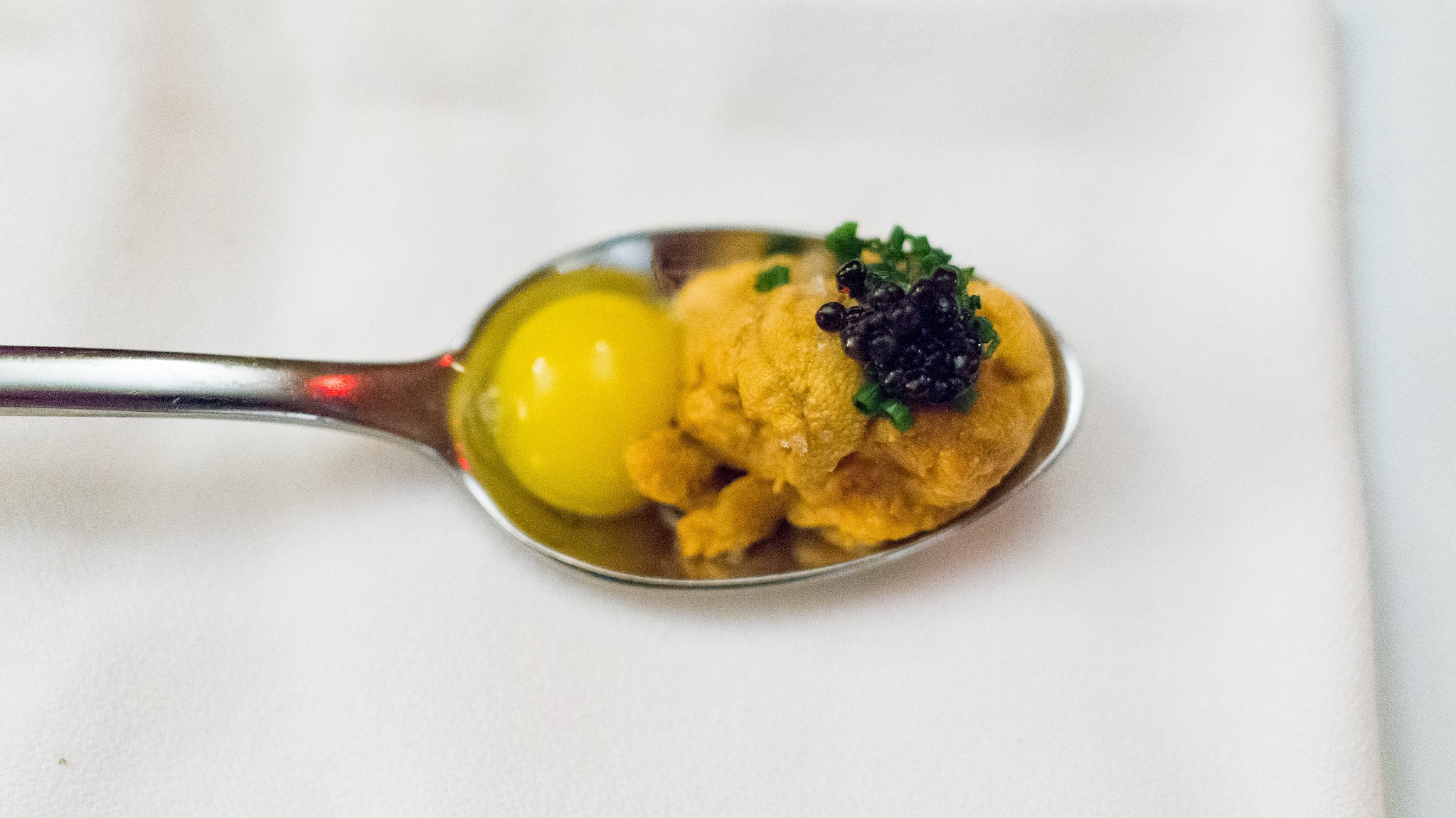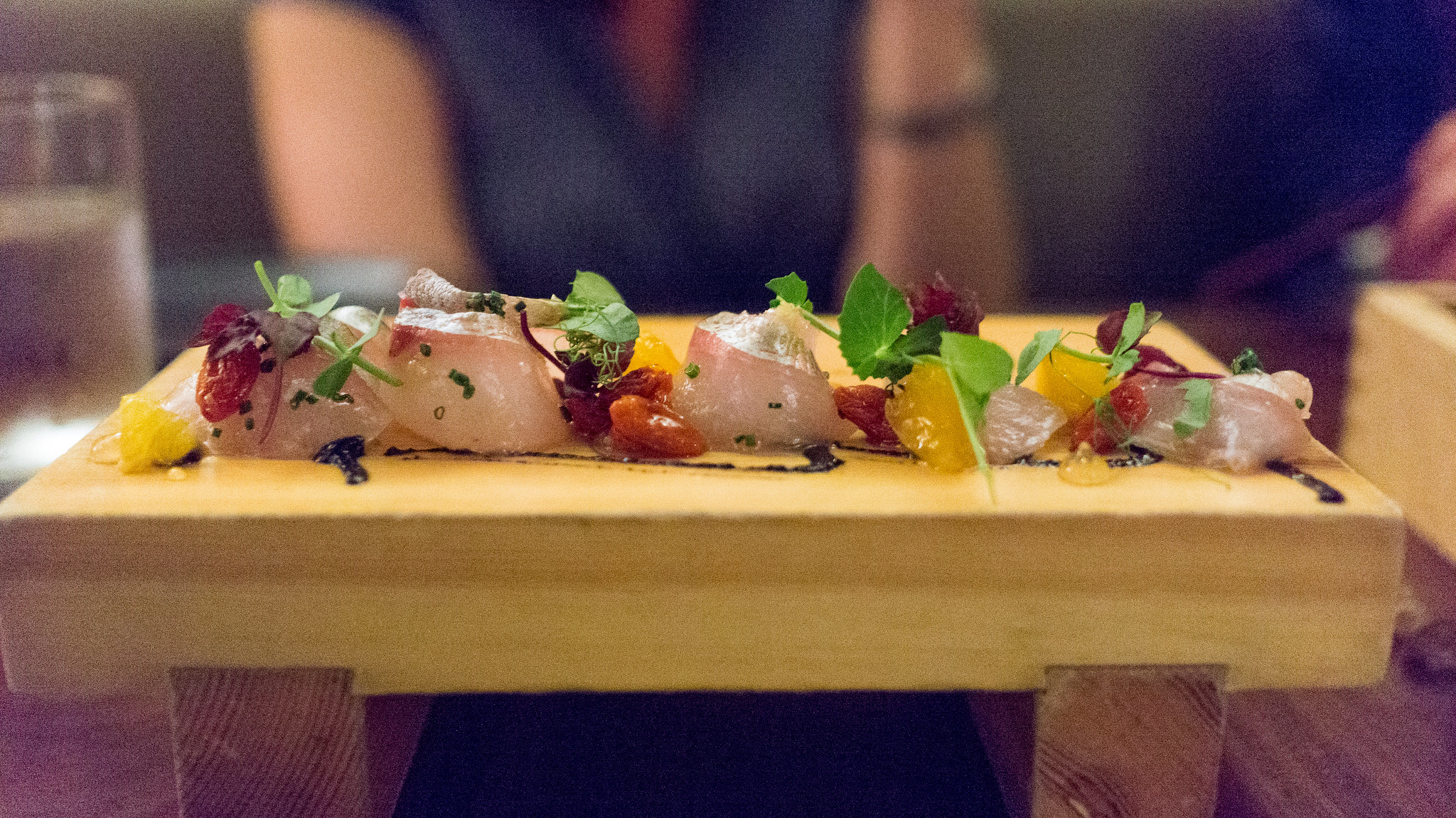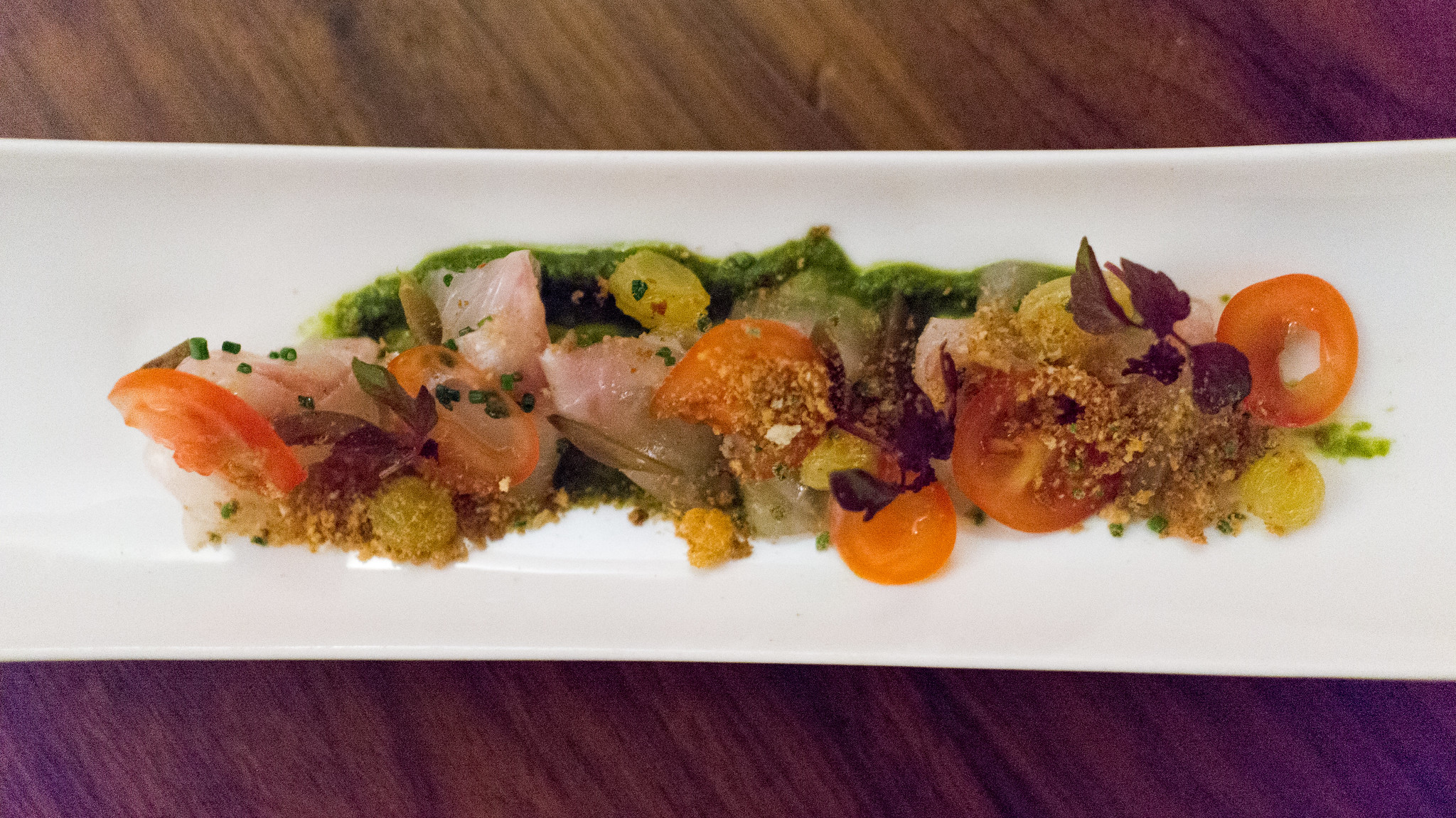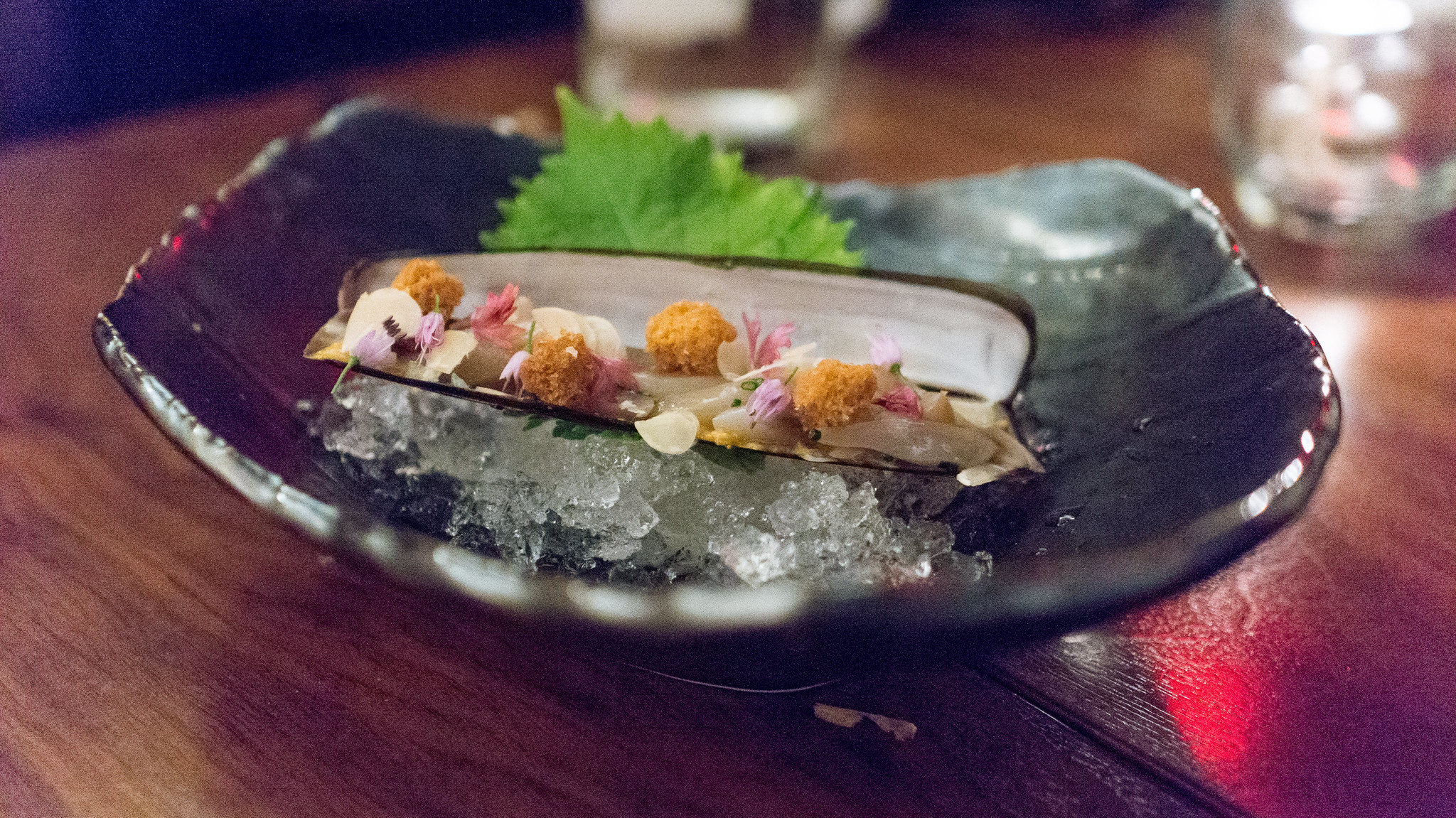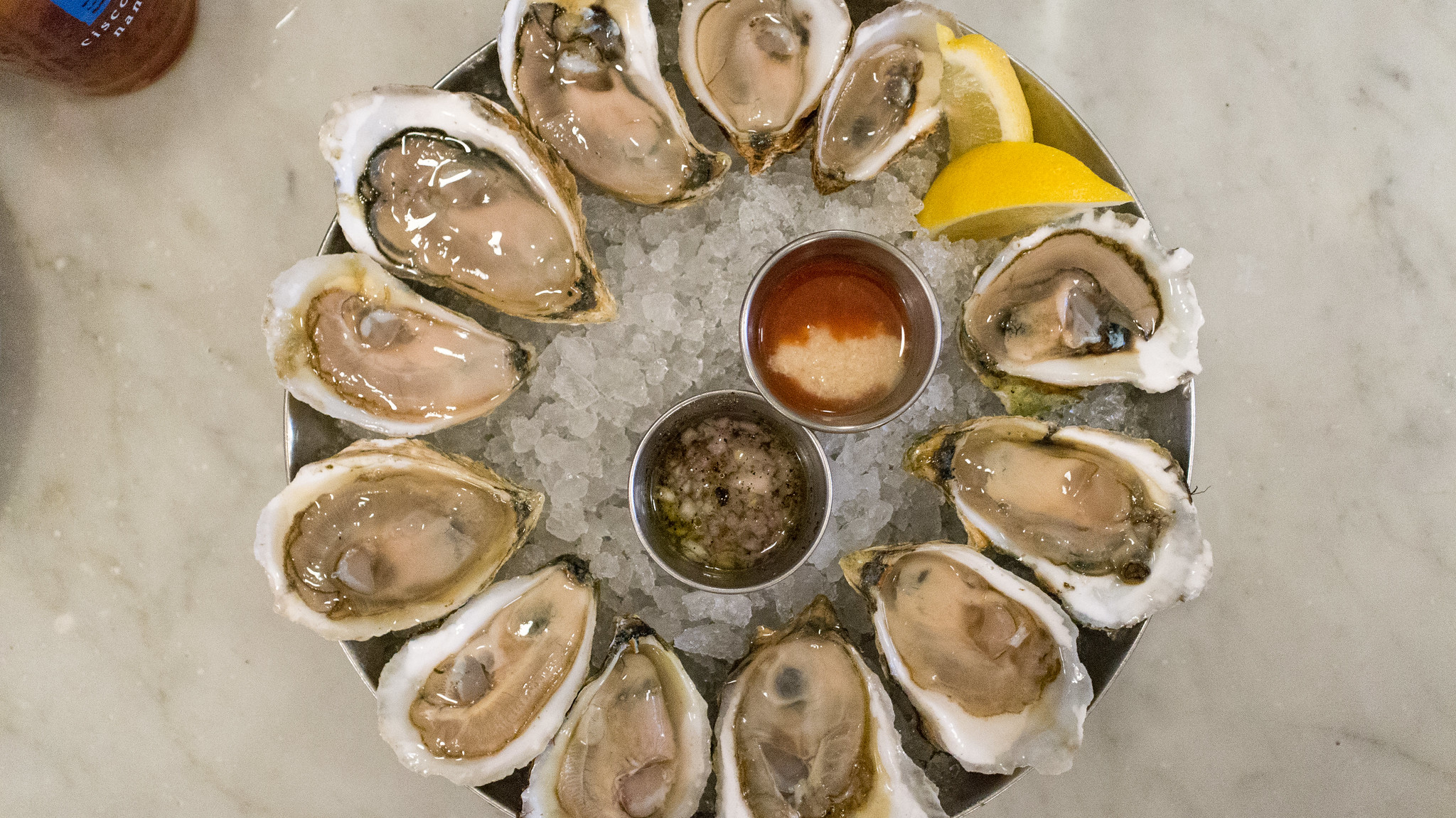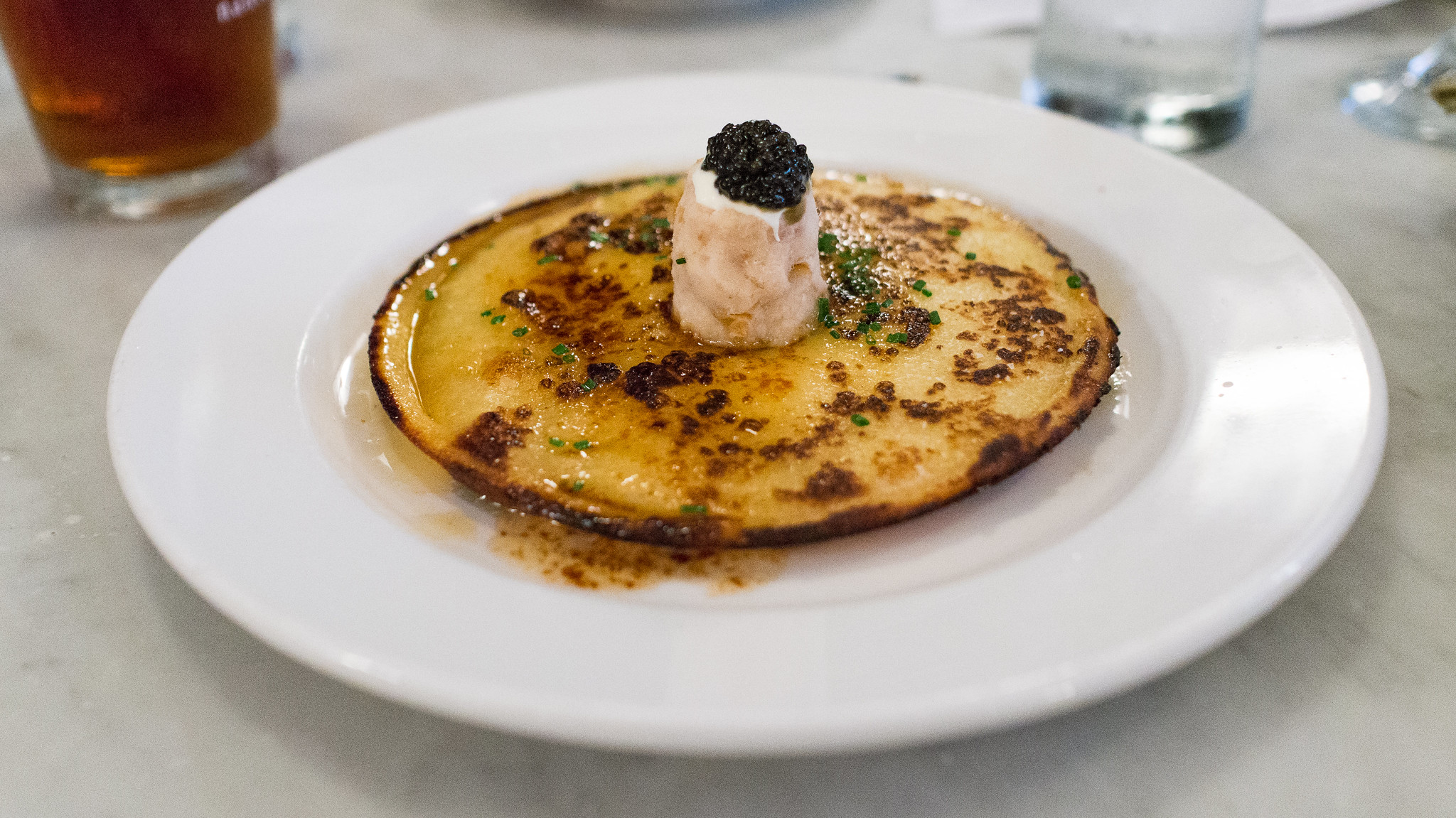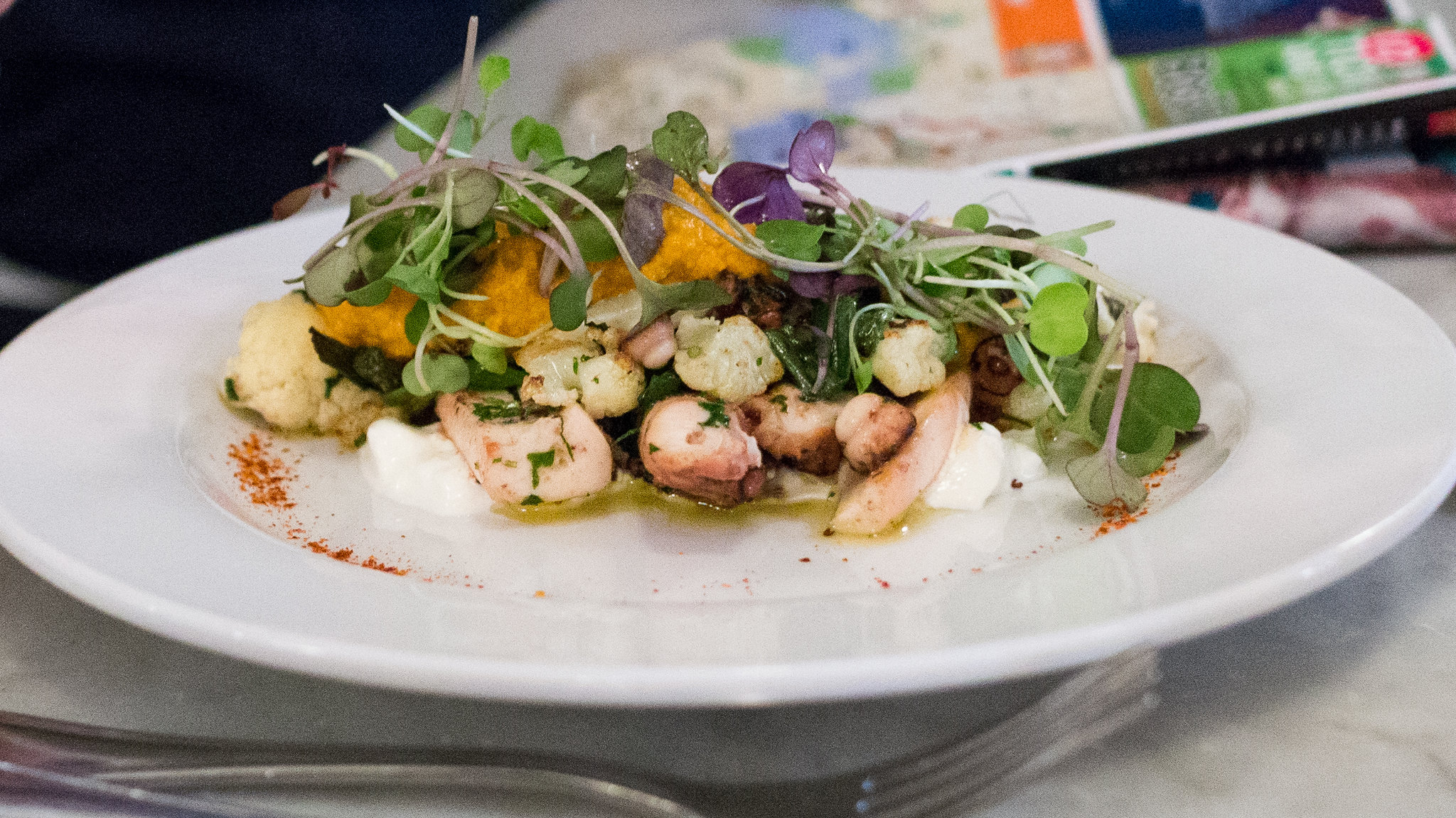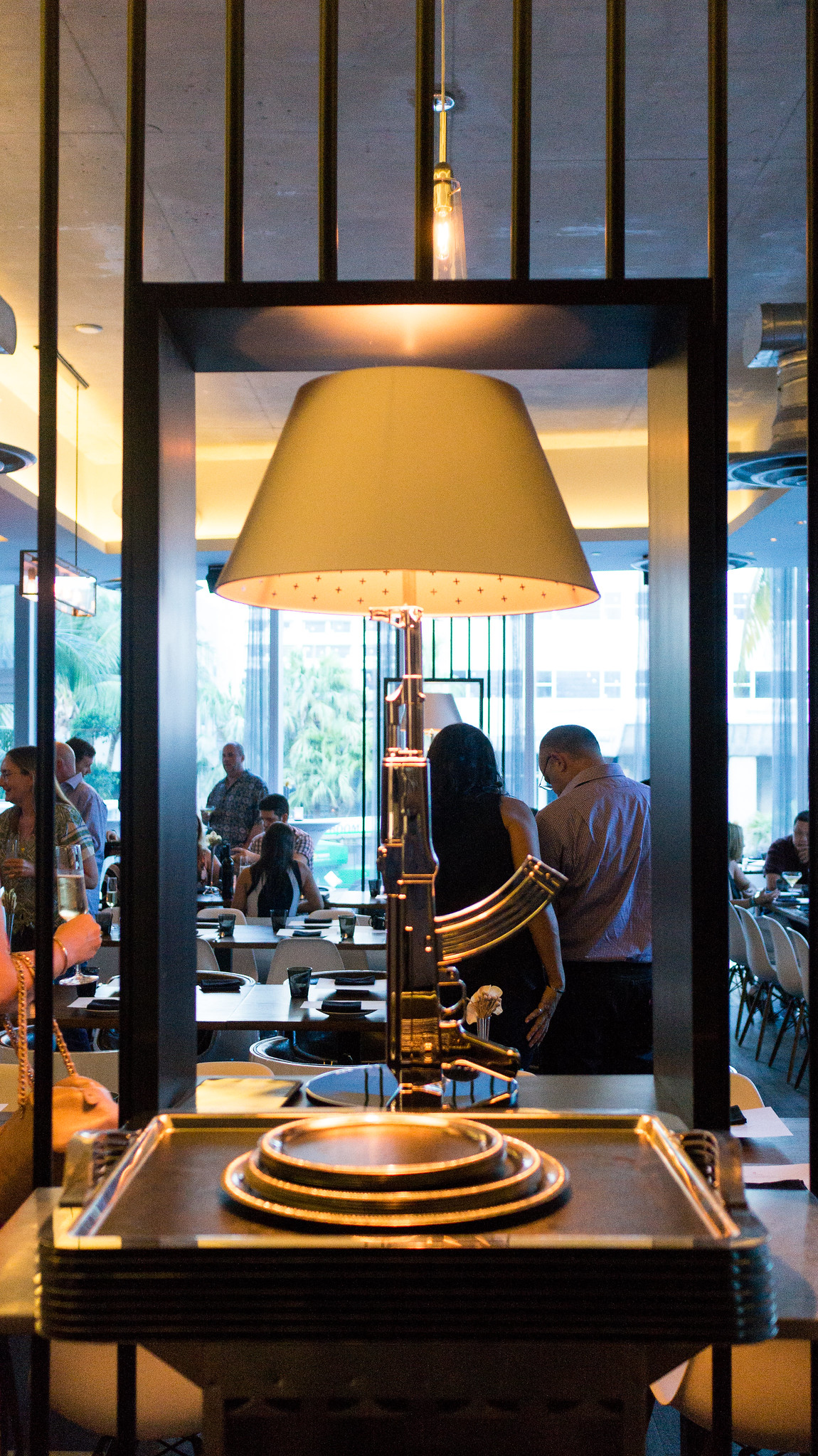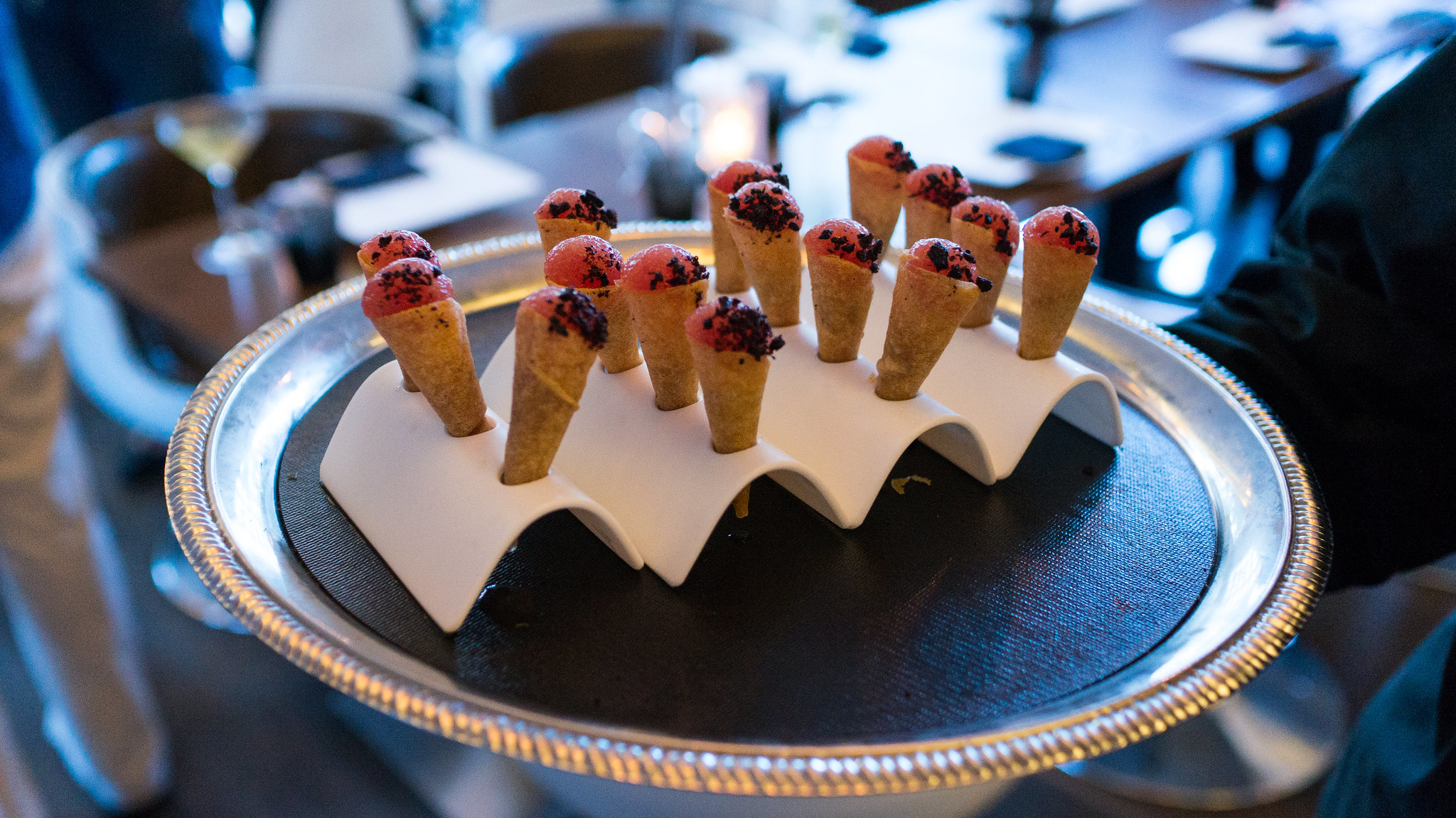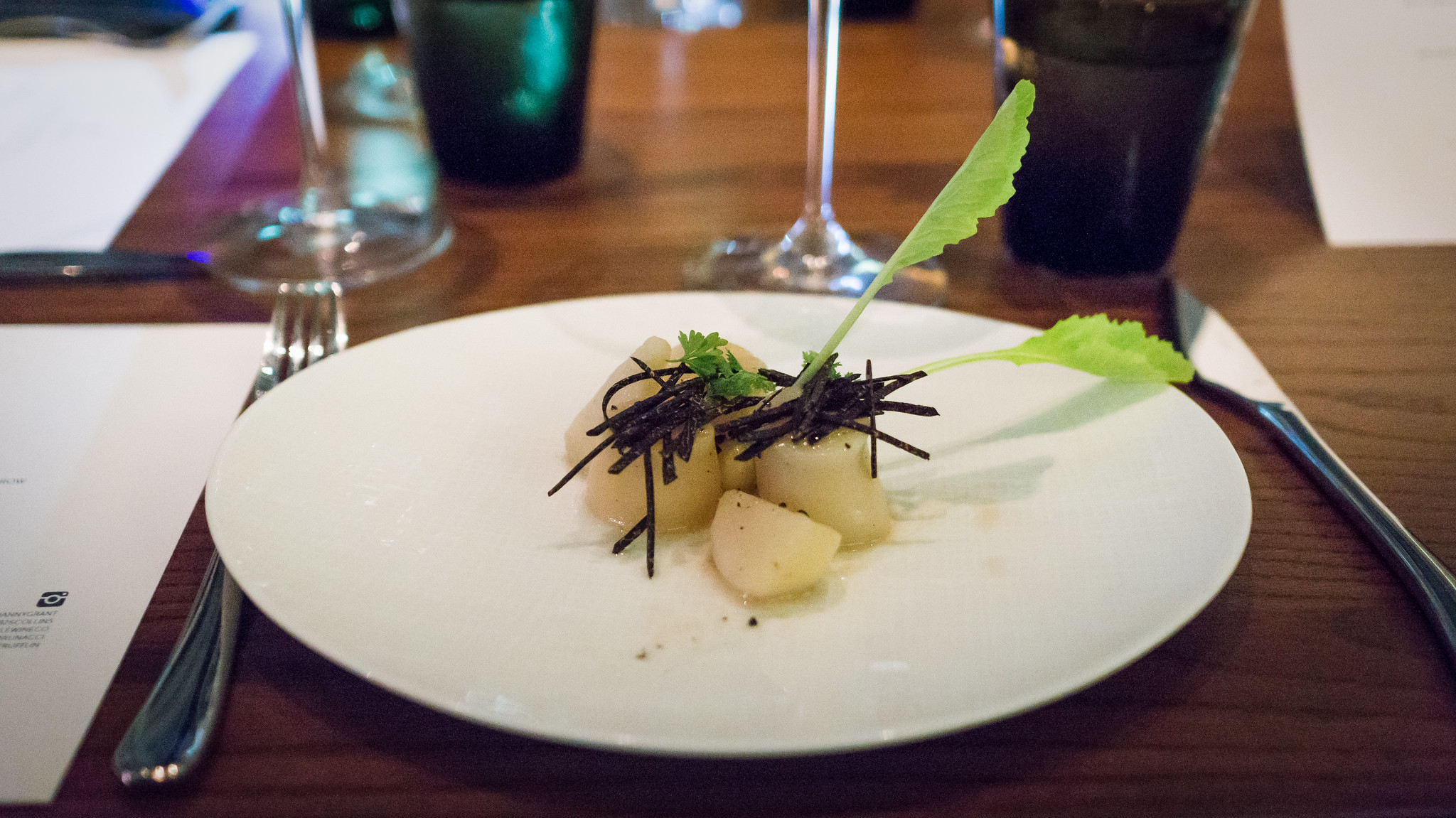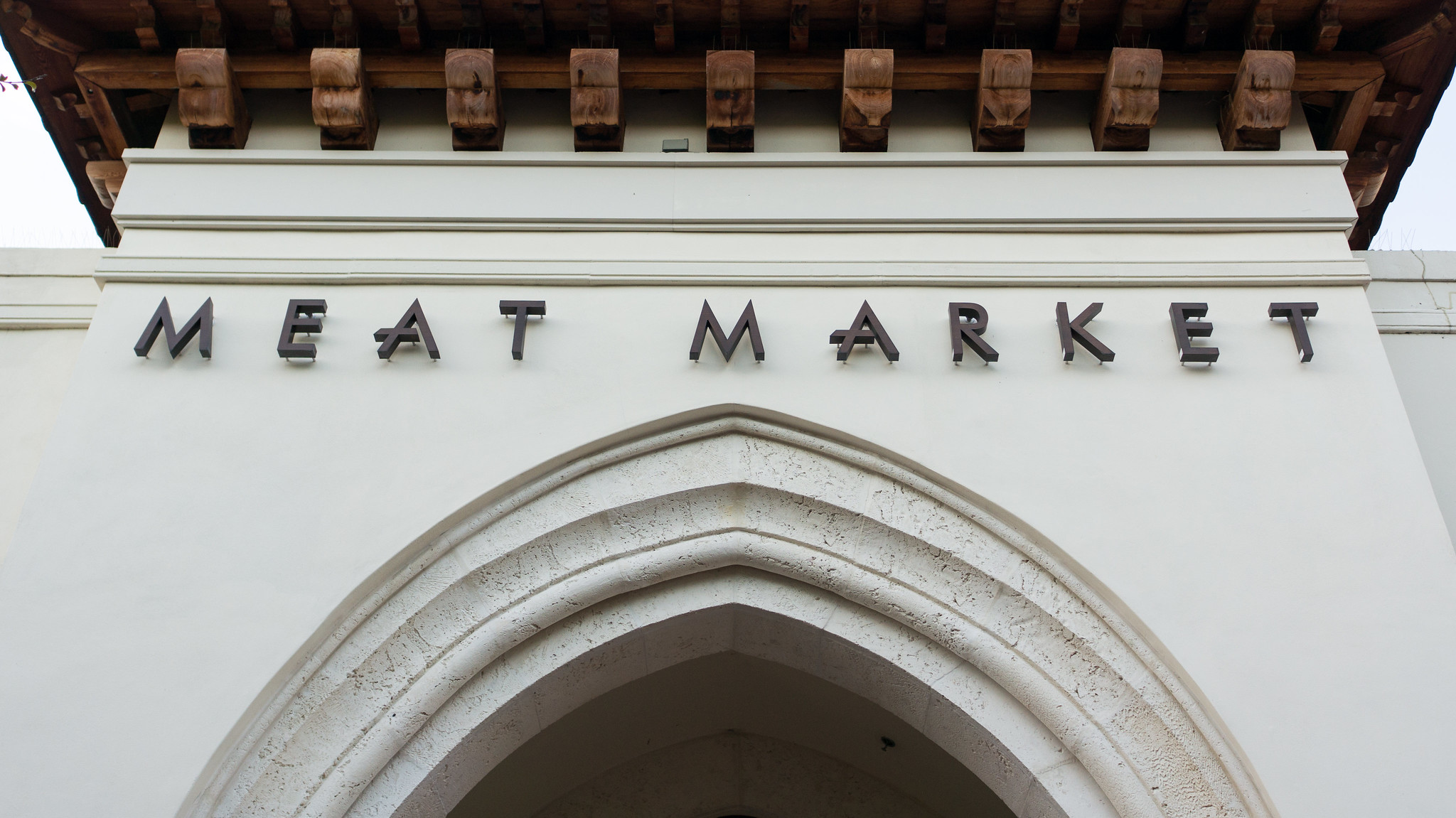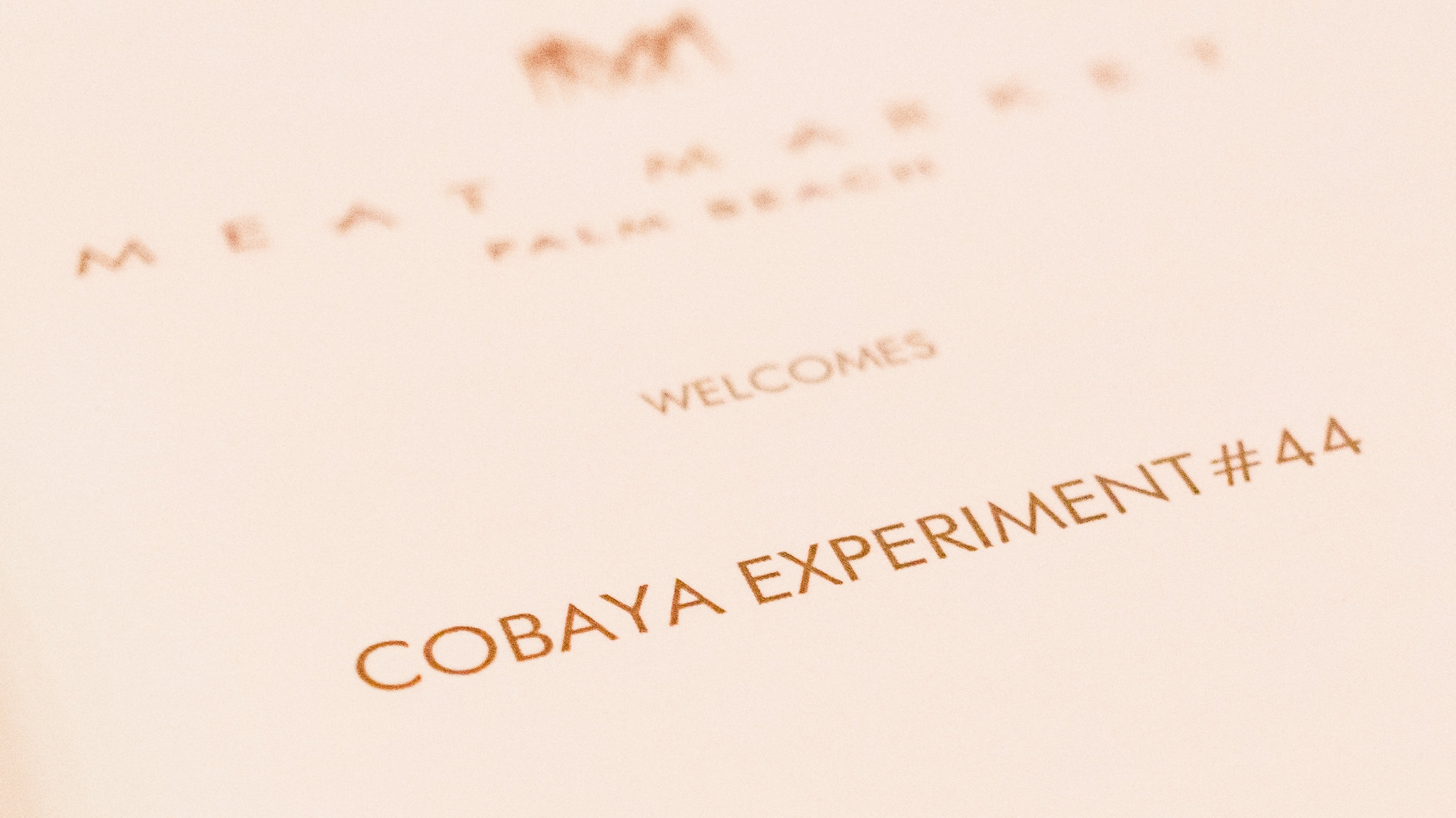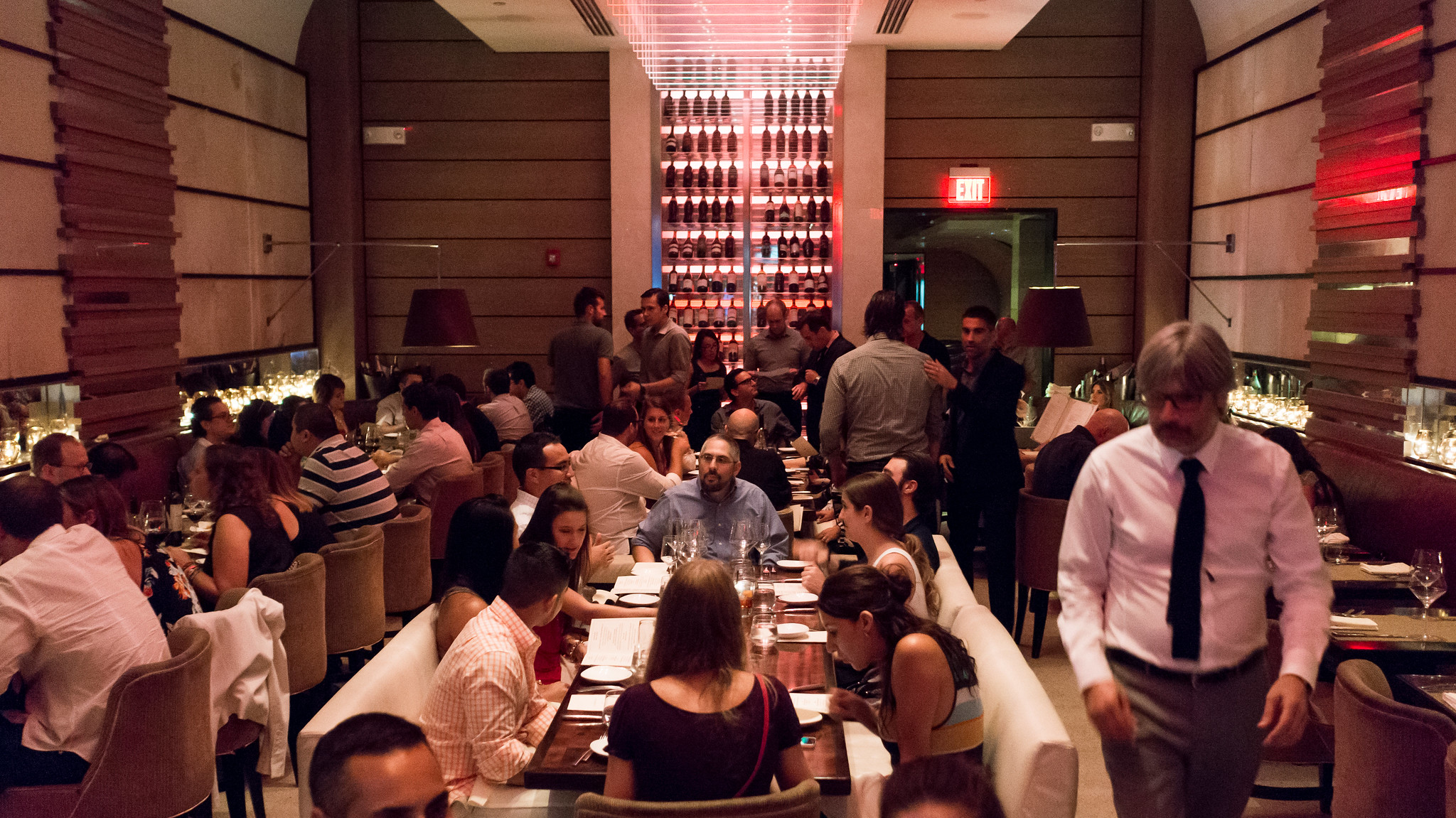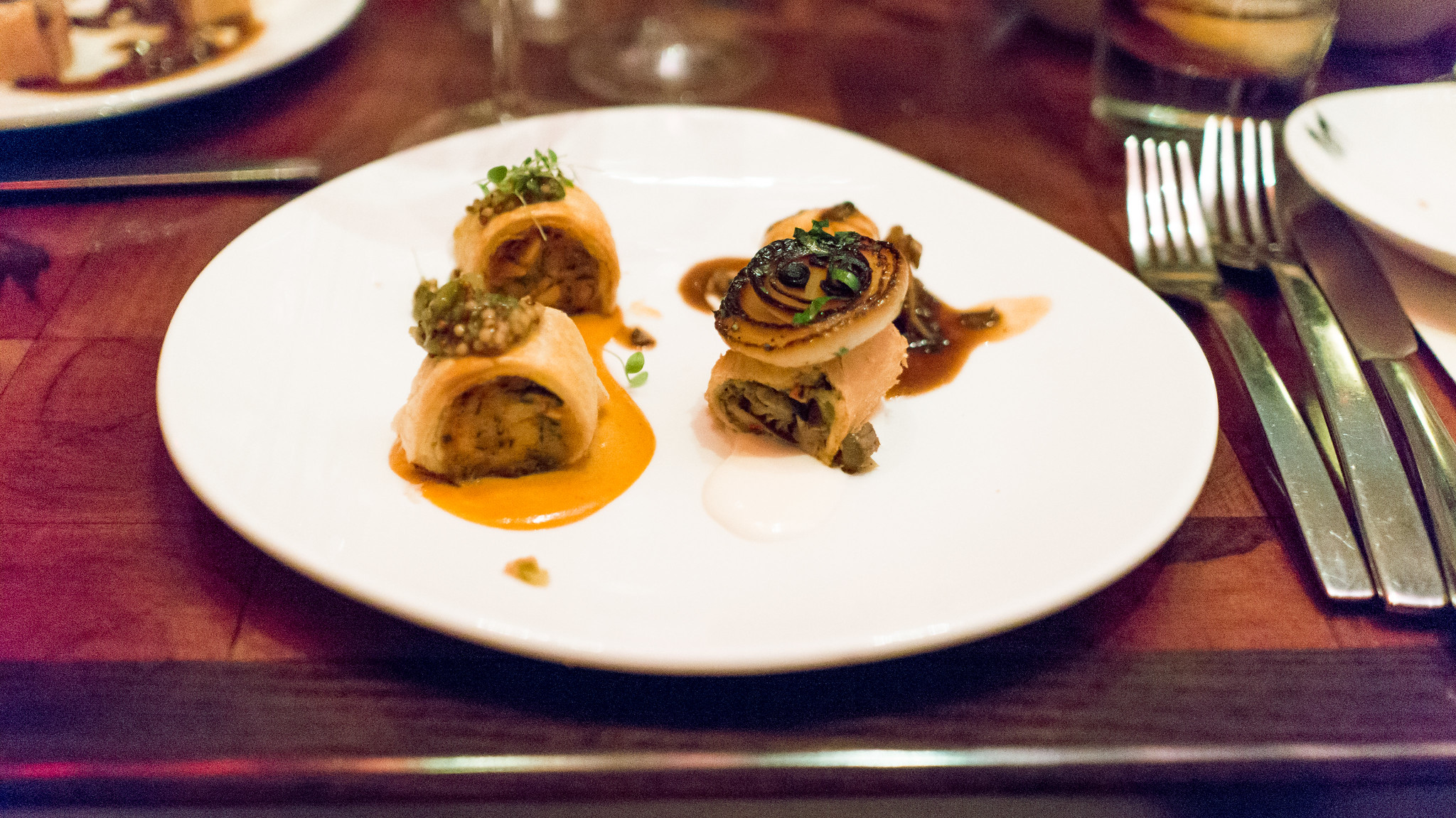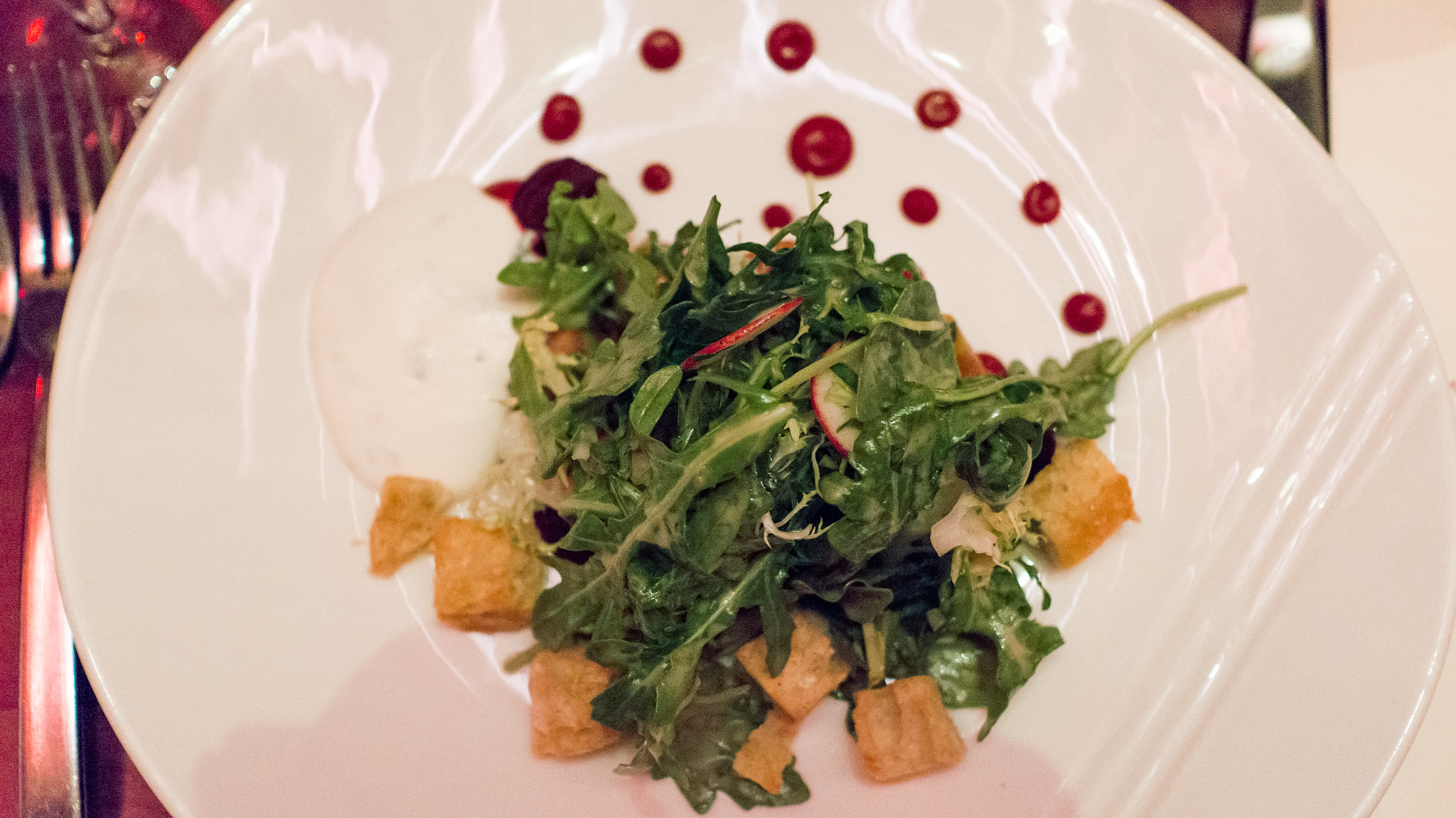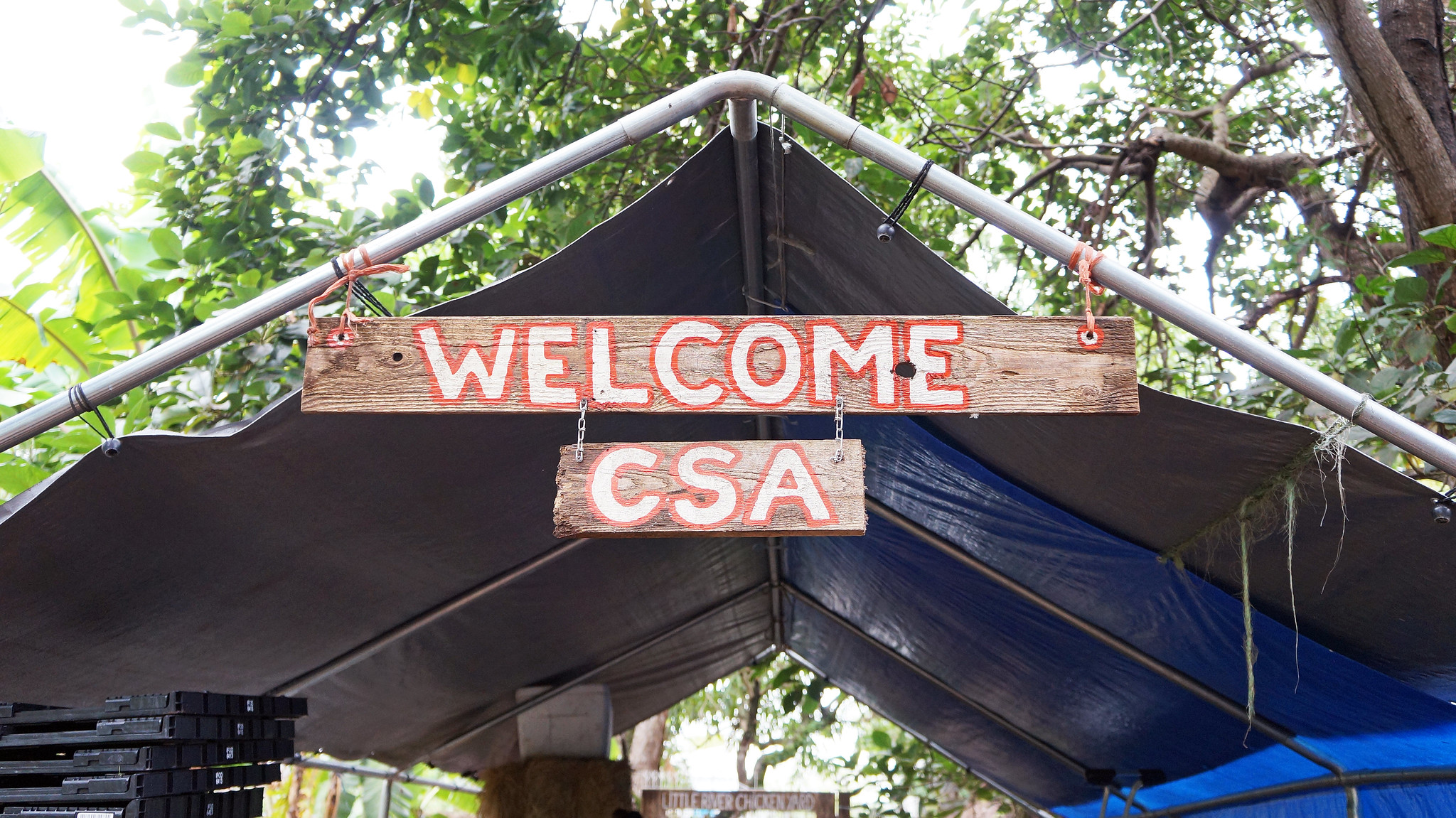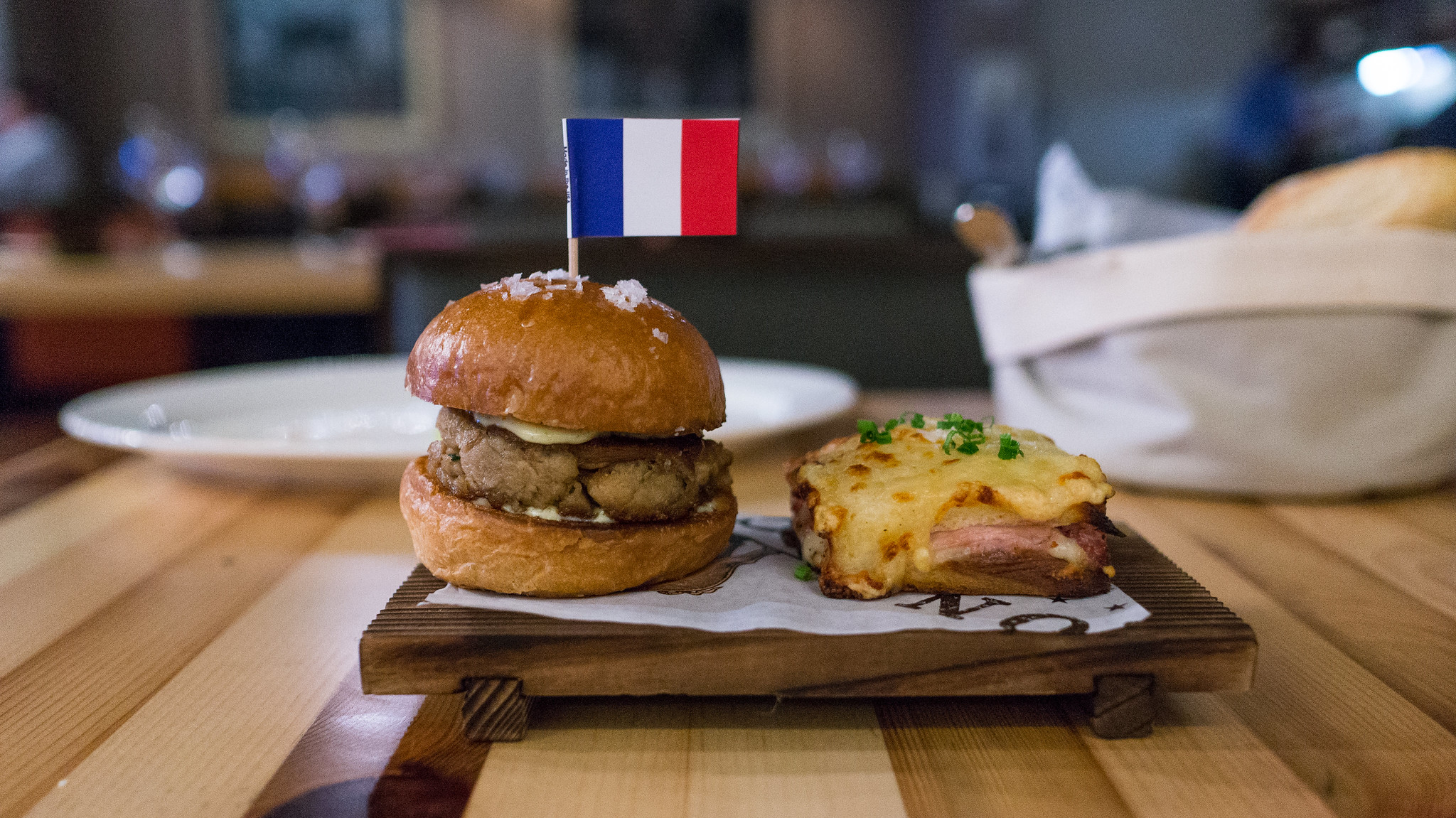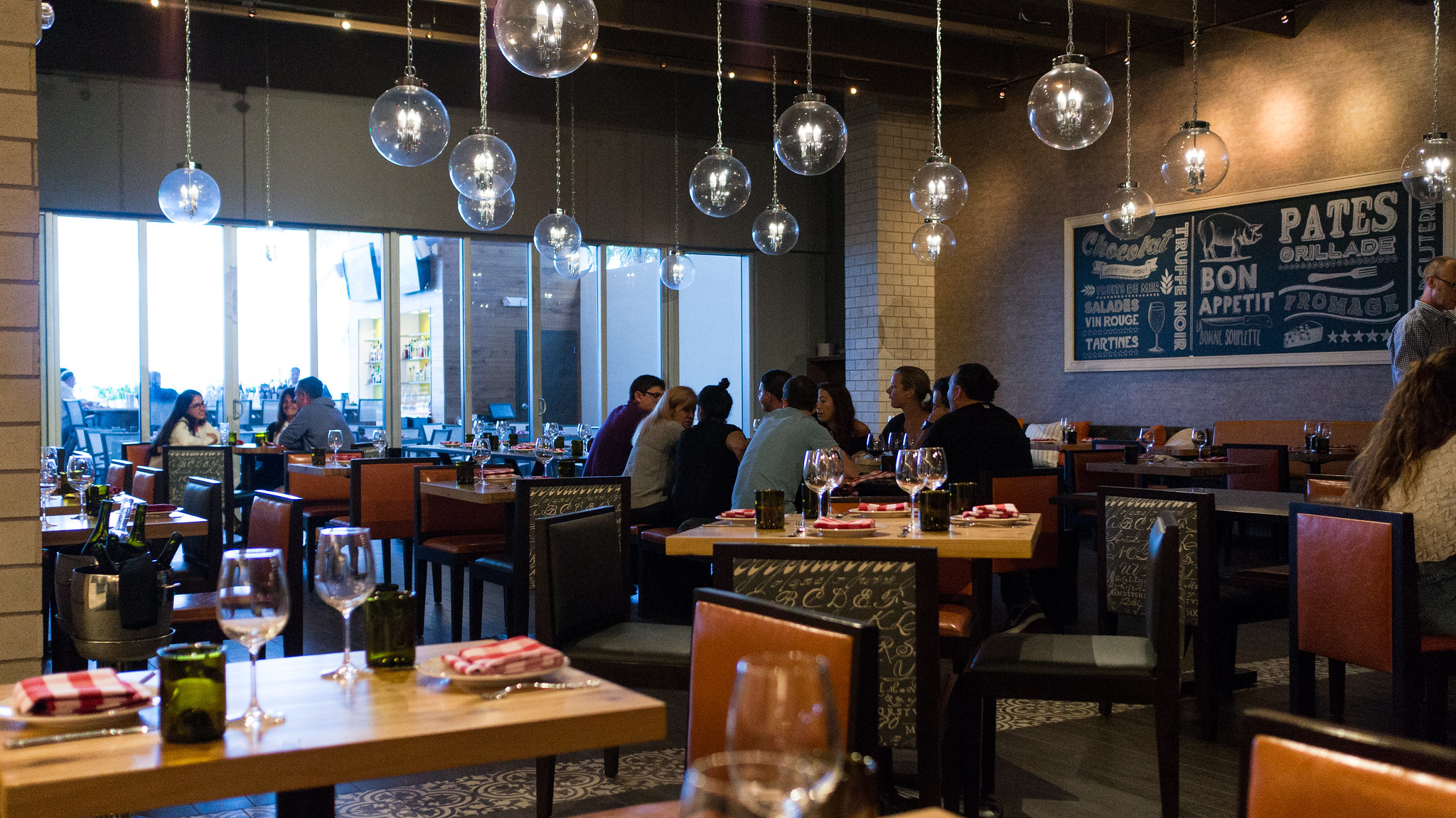I knew once we'd decided to go to Boston that we'd have to visit a Ken Oringer place. He's a chef I've followed from afar for years, one whose menus I'd read and feel like I could already taste them. It was tough to pass on Clio and Toro, but I've been on something of a seafood kick lately and so Uni Sashimi Bar was the choice.
Our dinner at Uni didn't start particularly well, though. It took nearly ten minutes after being seated before our waiter even graced us with his presence, and then an equal amount of time before he could make a return visit to bring menus and pour water. It was an oddly ignominious introduction to the place, particularly given that the entire restaurant is about the size of a reasonably spacious living room, and we could see him rearranging chairs around empty tables as we anxiously awaited some semblance of service.
(You can see all my pictures in this Uni Sashimi Bar flickr set).
Fortunately, it was all uphill once the food started coming out. The menu at Uni is composed almost exclusively of small plates of raw fish, but the accompaniments and presentations are much more genre-bending than the "sashimi bar" in the name would suggest. As just one example, the namesake sea urchin roe is smoked, then folded onto a soup spoon together with a raw quail egg, a mound of osetra caviar, and a sprinkle of snipped chives for one luxurious, indulgent bite.
One of my favorite fish, silver-skinned shima aji, came cut into thick ribbons and paired with orange segments, goji berries and a black sesame drizzle, the sweet-tart fruit a nice foil for the oily flesh of the fish. Lubina (sea bass) was done in a Mediterranean inspired style, with green charmoula, plumped golden raisins and a sprinkle of preserved lemon gremolata. An elegantly presented razor clam invoked Catalan flavors: romesco sauce, Marcona almonds, crispy migas.
(continued ...)
Monday, September 29, 2014
Saturday, September 27, 2014
Neptune Oyster Bar - Boston
The "to do" list ("to write," to be more precise) keeps growing longer and more intimidating. In the interest of paring it down, let me try to catch up on some of our latest excursions.
In the summer, we tend to head north in the interest of finding cooler climes than our ninety degree, ninety percent humidity weather here in Miami. This July included a long weekend in Toronto, which will be the subject of another report (the twitter version: a fun place to visit and a fun place to eat). August found us first in Boston, from where we headed up the coast to Maine, then across the border to Quebec City before wrapping up in Montreal.
Our Boston visit started with a place that's been open just shy of ten years, and has all the feel of a classic: Neptune Oyster Bar. We had fortuitous timing, squeezing in to seats at the end of the counter before the lines started to form for lunch (the tiny spot has only a couple dozen seats at tables plus another fifteen at the bar).
(You can see all my pictures in this Neptune Oyster Bar flickr set).
I can see why they're lining up. The oysters, with a choice from among a dozen primarily east coast varieties, were excellent. This particular dozen included, working clockwise from the lemon wedges, Wellfleet, Island Creek and Bee's River from Massachusetts, Browne's Point and Pemaquid from Maine, and Beausoleil from New Brunswick Canada.
But the oysters aren't the only draw here. This buttermilk johnnycake, topped with a mound of smoked trout tartare wearing a sturgeon caviar hat, then doused in melted honey butter, was a fascinating mix of earthy, smokey, fishy, salty and sweet flavors. I would have never guessed that the savory/sweet sausage/pancake breakfast type thing could be taken in an aquatic direction, but this worked. A Spanish-inspired grilled octopus salad, with crisp browned nubs of roasted cauliflower and a ruddy orange romesco sauce, was another good combination, light but hearty and full-flavored.
(continued ...)
In the summer, we tend to head north in the interest of finding cooler climes than our ninety degree, ninety percent humidity weather here in Miami. This July included a long weekend in Toronto, which will be the subject of another report (the twitter version: a fun place to visit and a fun place to eat). August found us first in Boston, from where we headed up the coast to Maine, then across the border to Quebec City before wrapping up in Montreal.
Our Boston visit started with a place that's been open just shy of ten years, and has all the feel of a classic: Neptune Oyster Bar. We had fortuitous timing, squeezing in to seats at the end of the counter before the lines started to form for lunch (the tiny spot has only a couple dozen seats at tables plus another fifteen at the bar).
(You can see all my pictures in this Neptune Oyster Bar flickr set).
I can see why they're lining up. The oysters, with a choice from among a dozen primarily east coast varieties, were excellent. This particular dozen included, working clockwise from the lemon wedges, Wellfleet, Island Creek and Bee's River from Massachusetts, Browne's Point and Pemaquid from Maine, and Beausoleil from New Brunswick Canada.
But the oysters aren't the only draw here. This buttermilk johnnycake, topped with a mound of smoked trout tartare wearing a sturgeon caviar hat, then doused in melted honey butter, was a fascinating mix of earthy, smokey, fishy, salty and sweet flavors. I would have never guessed that the savory/sweet sausage/pancake breakfast type thing could be taken in an aquatic direction, but this worked. A Spanish-inspired grilled octopus salad, with crisp browned nubs of roasted cauliflower and a ruddy orange romesco sauce, was another good combination, light but hearty and full-flavored.
(continued ...)
Tuesday, August 26, 2014
Cobaya 1826 with Chef Danny Grant
At Cobaya, we love when chefs have passions they wish to pursue. When we first started talking to Chef Danny Grant about doing a dinner, he told us his passion was truffles. Initially I was puzzled when he said he wanted to do a truffle-themed dinner in the dead of August, when I'm accustomed to only seeing – and being disappointed by – summer truffles.[1] But Danny said he was bringing in Australian black Perigord truffles, and that they were great.
Grant is the chef at 1826 Restaurant & Lounge, a restaurant, bar and lounge in the heart of South Beach that opened last year. Before coming to Miami to open 1826, he had made a name for himself in Chicago heading the kitchen at the now-closed RIA, which garnered two Michelin stars during Danny's tenure in 2011-12 (and during which time he also earned a "Best New Chefs" recognition from Food & Wine magazine). Danny's resume – and the samples of his cooking I've had from a visit to the restaurant and the dish he contributed to our Cobayapalooza dinner last month – gave me some confidence in his judgment. We let him go with it, and I'm glad we did.
The truffles – eight pounds worth, supplied by Truffle & Wine Co., whose VP of sales, Frank Brunacci, was in attendance – were a revelation for me. The company started cultivating Perigord truffles in Australia more than ten years ago, inoculating oak trees with DNA-tested Perigold truffle fungus (tuber melanosporum), and produced their first truffle seven years later. I don't know how you pitch that business plan, but I'm grateful someone supported it. Maybe it was luck of the draw, as the quality of truffles generally can vary considerably – but if these were only 90% as good as the best Perigord truffles I've had from France, they were 100% better than many of the muted, bland ones I've still paid top dollar for, with an intense, complex, musky aroma of earth and underbrush and smoke.
Here's what Danny did with them:[2]
(You can see all my pictures in this Cobaya 1826 flickr set).
As guests started to fill the dining room, a couple passed appetizers were circulated - kumamoto oysters bathing in a truffle-infused cream, and these Keller-style tuna tartare cornets topped with a dusting of citrus and black truffle.
There were six courses listed on his printed menu, but once everyone was seated, Danny also added this off-menu amuse bouche: a couple delicate foie gras and truffle filled dumplings, swimming in an ice wine consommé that was poured tableside. Really elegant and clean stuff, especially that limpid, golden-hued broth.
Aside from the hurdle of convincing diners that summer truffles can be as good as the winter varieties, an additional challenge is what you do with them. Many typical truffle recipes – risottos, pastas, beef w Perigord sauce – are heavy, winter dishes. Grant responded to that challenge with a delicate seafood dish that made perfect sense for a hot Miami summer. Sea scallops were poached in milk infused with aromatics and black truffle, then served along with lobes of Hakurei turnip cooked to a similar tender consistency, all draped with a truffle vinaigrette, showered with matchsticks of black truffle, and topped tableside with a foamy "fumé blanc" sauce.
(continued ...)
Grant is the chef at 1826 Restaurant & Lounge, a restaurant, bar and lounge in the heart of South Beach that opened last year. Before coming to Miami to open 1826, he had made a name for himself in Chicago heading the kitchen at the now-closed RIA, which garnered two Michelin stars during Danny's tenure in 2011-12 (and during which time he also earned a "Best New Chefs" recognition from Food & Wine magazine). Danny's resume – and the samples of his cooking I've had from a visit to the restaurant and the dish he contributed to our Cobayapalooza dinner last month – gave me some confidence in his judgment. We let him go with it, and I'm glad we did.
The truffles – eight pounds worth, supplied by Truffle & Wine Co., whose VP of sales, Frank Brunacci, was in attendance – were a revelation for me. The company started cultivating Perigord truffles in Australia more than ten years ago, inoculating oak trees with DNA-tested Perigold truffle fungus (tuber melanosporum), and produced their first truffle seven years later. I don't know how you pitch that business plan, but I'm grateful someone supported it. Maybe it was luck of the draw, as the quality of truffles generally can vary considerably – but if these were only 90% as good as the best Perigord truffles I've had from France, they were 100% better than many of the muted, bland ones I've still paid top dollar for, with an intense, complex, musky aroma of earth and underbrush and smoke.
Here's what Danny did with them:[2]
(You can see all my pictures in this Cobaya 1826 flickr set).
As guests started to fill the dining room, a couple passed appetizers were circulated - kumamoto oysters bathing in a truffle-infused cream, and these Keller-style tuna tartare cornets topped with a dusting of citrus and black truffle.
There were six courses listed on his printed menu, but once everyone was seated, Danny also added this off-menu amuse bouche: a couple delicate foie gras and truffle filled dumplings, swimming in an ice wine consommé that was poured tableside. Really elegant and clean stuff, especially that limpid, golden-hued broth.
Aside from the hurdle of convincing diners that summer truffles can be as good as the winter varieties, an additional challenge is what you do with them. Many typical truffle recipes – risottos, pastas, beef w Perigord sauce – are heavy, winter dishes. Grant responded to that challenge with a delicate seafood dish that made perfect sense for a hot Miami summer. Sea scallops were poached in milk infused with aromatics and black truffle, then served along with lobes of Hakurei turnip cooked to a similar tender consistency, all draped with a truffle vinaigrette, showered with matchsticks of black truffle, and topped tableside with a foamy "fumé blanc" sauce.
(continued ...)
Sunday, August 3, 2014
Cobaya Brasel at Meat Market
I'm not really sure what happened. I know Sean Brasel is a talented chef: I've had good meals at the restaurant of which he's chef and owner, Meat Market on Lincoln Road, and I've seen some interesting menus that he's put together for wine dinners there.[1] But if I'm going to be brutally honest – and I am – our Cobaya dinner at Meat Market just wasn't as good as dinners I've had at the restaurant, nor as interesting as other special event menus I've seen them do.
This puts me in an incredibly awkward position. As one of the organizers of these Cobaya dinners, I'd like nothing better than to tell you how fantastic every meal is, and heap praise on the chefs who work with us. Fortunately, I almost always get to do that, and through 44 events over the past five years, I think we've got a pretty great track record. But if I'm going to maintain credibility, I have to tell you when I think we miss the mark – and as a paying customer myself (we organizers buy our own seats), I feel it just as much as our guests.
The truth is, Experiment #44 was pretty disappointing to me, both in concept and execution. We give chefs free reign to create their menus, with the knowledge that they will have a group of adventurous, unrestricted eaters as their audience. Brasel apparently decided to use the opportunity to do a dry run of menu items for his new restaurant opening soon in Palm Beach. Though I guess we were the "guinea pigs," the result felt more like a Miami Spice menu than a dining experiment.[2]
(You can see all my pictures in this Cobaya Meat Market flickr set).
For a first course, we started with lobster pigs in a blanket (a sort of lobster forcemeat wrapped in puff pastry, served over a lobster mayo and topped with a potent mustard seed relish) and buffalo cheese steak rolls (topped with a bruléed cipollini onion and served over a cheese fondue and a heavily reduced mushroom jus). These are destined to be bar snacks at the new Palm Beach venue, and that's exactly what they tasted like: crispy, saucy, and very salty.
Next course was a beet and goat cheese salad. I guess I'm just surprised when you tell a chef, "You can make whatever you want!" and the response is, "I'm going to make a beet and goat cheese salad!" It was a fine salad – a mound of arugula and frisée dressed with a truffle vinaigrette hiding some nice roasted baby beets, with a dollop of goat cheese mousse, dots of beet purée and some crisp, airy, croutons – but it's also the kind of thing you can find on nearly every menu in town.[3]
(continued ...)
Monday, July 28, 2014
Cobayapalooza at Shikany
Typically, we use our Cobaya dinners as a way of turning a spotlight on a particular chef, to give them free reign to craft a menu that gives voice to their creative impulses or personal culinary obsessions. But collaboration has its rewards too, and we've long hoped to do a dinner that would bring together several local chefs to cook a meal.
That opportunity finally presented itself through the generosity of chef Michael Shikany, who opened the kitchen of his new restaurant in Wynwood – Shikany – to several other chefs for a "Cobayapalooza" dinner on July 16. Shikany and his pastry chef Jill Montinola were joined by Diego Oka of La Mar Miami, David Sears of SushiSamba Coral Gables, Mathias Gervias of the Setai, Danny Grant of 1826 Restaurant and Lounge, and Timon Balloo of Sugarcane Raw Bar Grill and Bocce Bar, who collectively put together a nine-course menu loosely organized around the great La Boîte spice blends made by Lior Lev Sercarz (each dish used a different La Boîte custom blend).
The restaurant was an ideal setting for the event, with room for nearly fifty guinea pigs in the stylish dining room, as well as for all the chefs and their crews in a bright, wide open kitchen. It was a great opportunity to highlight both an ambitious new restaurant, and a number of other talented young chefs working in Miami – several of them fairly new faces.
(You can see all my pictures in this Cobayapalooza flickr set).
Course 1 (Galil N. 13) Fresh Diver Scallop Crudo
Michael Shikany
Shikany started things off with a diver scallop crudo, thin ribbons of the shellfish topped with diced strawberries, pickled watermelon rind, and white truffle oil, and plated with a swoop of black garlic aioli, a powdered creme fraiche sorbet, dots of hibiscus gel and still more items I've lost track of. A lot of flavors, a lot of techniques; but also a really good, fresh, plump, sweet scallop as the centerpiece of it all.
Course 2 (Coquelicot N. 24) Oysters & Salmon
David Sears
Next up, David Sears of SushiSamba, who served a round of tender salmon topped with a crust of poppy seeds and spices (almost an "everything bagel" kind of thing going on here), accompanied by a tangled salad of sorts of oysters, pickled onions and sweet cherry tomatoes, accompanied by generous dollops of jet black sturgeon caviar and cool creme fraiche.
Course 3 (Luberon N. 4) Wild Quahog
Michael Shikany
Back to Shikany for the next course, a sort of cross between sashimi and ceviche featuring – among other things – a fat quahog clam, ribbons of madai (Japanese sea bream), assorted seaweeds, cubes of tofu and purple Okinawa potato, dabs of puréed sweet potato, tiny caviar of "Coke syrup," an herbaceous green emulsion, and a little squirt bottle of a spicy soy sauce to apply in DIY fashion. I think the perfumey, lavender-forward Luberon spice blend was making its appearance in the dabs of translucent fluid gel interspersed around the fish.
Course 4 (Vadouvan N. 28) Yellowtail Snapper
Diego Oka
Diego Oka's yellowtail dish was, for me, one of the most intriguing of the night. While ceviche tends to get all the attention these days, there's an incredible diversity to Peruvian cooking, which his dish highlighted. The fish was served over a curry-spiced, chocolate-dusted potato stew, which had a fascinating, nubby texture and great depth of flavor.A translucent quinoa crisp, peanut butter powder and a sauce of huacatay (Peruvian black mint, with a zing sort of between typical mint and basil) completed the dish.
(continued ...)
Wednesday, July 23, 2014
Big Things at Little River CSA
For the past few years I've subscribed to a CSA (Community Supported Agriculture) vegetable share through Little River Market Garden, and periodically (OK, sporadically) posted about it here. Muriel Olivares operates a flourishing, but small, "urban farm" from a couple lots in residential neighborhoods in North Miami which produce several dozen varieties of vegetables and fruits. Though it's self-evident from the primary subject matter of this blog that I enjoy dining out, I always get excited when our Fall-Spring South Florida growing season kicks in, and the weekly pickup from farmer Muriel inspires a bit more home cooking.
For this upcoming season there are several new developments of note. First off, there's a new name: Little River Cooperative, as Muriel has partnered with former intern Tiffany Noe to run the farm, CSA and nursery. It's even got a sharp looking new website. The partnership will enable them to add more growing space, which is also going to mean more CSA shares will be available.
Speaking of which, there will now be an option to choose a large share or small share ($640/$500 for 20 weeks of vegetables), and in addition to the regular Saturday pick up location at the Upper East Side Farmers Market at Legion Park (Biscayne & 64th Street), there will also be a new Thursday afternoon pick up location further south at the Grove Green Market in Coconut Grove.
I've talked before about the kinds of things that elevate a food community. There may be none more important than farmers like Muriel and Tiffany who supply fresh local stuff, produced in a natural, sustainable fashion. Though the season doesn't start for a few more months, now is the time to sign up. To do so, or for some more information, go to the Little River Cooperative website.
Monday, July 14, 2014
first thoughts: L'Echon Brasserie - Miami Beach
First it was an Asian gastropub. Then, Spanish tapas. Sushi. Italian. A steakhouse. I would joke that when the Pubbelly Boys opened a burger joint, they'd be able to declare Miami restaurant "BINGO!"[1]
Instead, they went a different route – their latest project is L'Echon Brasserie, located in the Hilton Cabana hotel, up in the northern reaches of Miami Beach (i.e., 62nd Street). This makes me happy for at least a couple reasons: (1) Miami lacks good casual French restaurants; and (2) North Beach is closer to home for me than the rest of their South Beach outposts.
(You can see all my pictures in this L'Echon Brasserie flickr set).
The hotel, well, looks like a Hilton. And the dining room too is maybe a bit more corporate than other Pubbelly venues, but it still keeps some of the same spirit, and has the added virtue of an outdoor bar backing up to the ocean. The food, meanwhile, is very much in the typical Pubbelly style: it takes the classic French bistro menu as a jumping-off point for some contemporary, usually indulgent, and often pork-centric, variations.
For instance: chicken liver mousse, paired with fried chicken livers? Sometimes I think the Pubbelly style is a bit too heavy-handed, and then I try something like this. Or, pictured at top, the "Pan con L'Echon," a nice little slider of juicy cochinillo topped with pickled shallots and mojo aioli on a brioche bun, and the Croque Monsieur made with salty country ham, melty Gruyere cheese and an oozy bechamel.
(continued ...)
Subscribe to:
Posts (Atom)

